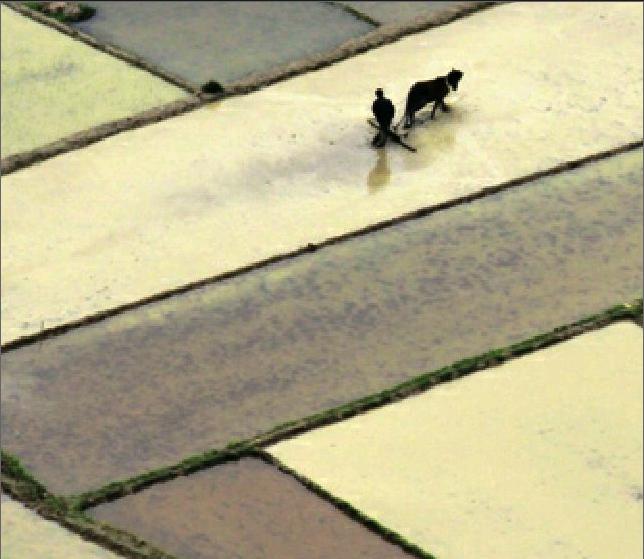Rural Transformation
2014-02-10ByLanXinzhen
By+Lan+Xinzhen

A dozen shipments of corn imported from the United States containing unapproved and genetically modified ingredients were denied entry by China in December 2013. Since China relies heavily on imported grain to guarantee its supplies, the action was considered by some market analysts as an unusual change. The change was confirmed as expected at the Central Rural Work Conference held in Beijing on December 23-24, 2013. Chinas new leadership hopes that the bowls Chinese people will mainly be filled with domestically produced grain.
China has long been a large agricultural nation, therefore the work concerning agriculture, countryside and farmers (the three rural issues) have always been the top priority of the Chinese Government. The Central Rural Work Conference provided the first opportunity for the countrys new government to make plans for the three rural issues.
Besides ensuring domestic production of grain, the conference also made decisions about the position of agriculture, safety of farm produce, land rights, development of rural areas and raising farmers income.
Cheng Guoqiang, a researcher with the Development Research Center of the State Council, thinks this conference has conveyed that the Chinese Government will, with the aim of boosting agricultural output to guarantee the countrys grain security, enrich the lives of farmers and accelerate the building of a welloff society in the countryside. They also seek to change the situation of agriculture falling behind other industries in economic and social development, and explore a road of agricultural modernization with Chinese characteristics.
Top priority
To feed the more than 1.3 billion people has always been the top priority for the Chinese Government. The Central Rural Work Conference proposed to uphold the national grain security strategy of mainly relying on domestic production, ensuring production capacity, importing grain in appropriate quantity and boosting agricultural scientific development. “Filling the bowls of the Chinese, in any situation, must rest soundly in our own hands,” a statement released after the conference read.
Dang Guoying, a researcher with the Rural Development Institute of the Chinese Academy of Social Sciences (CASS), thinks that although China has been stressing grain security, the conference more clearly emphasized taking initiatives to ensure food provisions.
According to Dang, currently China has adequate provisions in terms of both variety and quantity. However, there are hidden risks in grain production. The government has to encourage farmers to grow grain with high prices. For reasons of technology and scale, grain production costs in China are higher than in the United States and Brazil, where agriculture is highly developed. If China allows massive imports of cheap foreign grain, once global grain prices—which have remained low for a long time, start to rise—China will face great pressure. Hence it is timely and nec-essary that this conference puts forward a national grain security strategy.endprint
It is never easy to make “Chinese bowls filled with Chinese grain.” In recent years Chinas grain imports have been increasing. Since 2011, the country has become a net importer of wheat, rice and corn. Now China can ensure absolute security of provisions, but relies on imports for soybeans.
In regard to concerns that grain provisions will repeat the soybean situation in the future, this conference emphasizes the target to ensure self-sufficiency in cereal and absolute security of provisions. “This can be considered a red line for national grain security,” Cheng said.
The conference first emphasized that a red line should be drawn so the arable land never falls below 1.8 billion mu (120 million hectares). For soaring real estate prices, some scholars propose breaking through the red line and curbing estate prices by increasing land supplies in cities. The conference indicated that the Chinese Government will not solve the problem of high estate prices at the cost of grain security.
Xu Hongcai, Director of the Information Department of the China Center for International Economic Exchanges, said strictly following the red line on arable land is the basis to ensure self-sufficiency for most varieties of grain. By reemphasizing on the red line the government intends to take preventive measures. During the process of urbanization, China must set up a uniform land market between urban and rural areas, promote orderly transfer of rural land use rights and improve land concentration and scale of use. China has a large population but small amount of arable land, therefore it cannot randomly use arable land for other purposes. If the red line for arable land is crossed, grain security will be threatened.
After guaranteeing the red line on arable land, there must be a workforce to cultivate the land. Since the income from agriculture is much lower than urban jobs, many farmers have abandoned their land and become workers in cities, leaving some arable land idle. The conference also proposed solutions to this problem.
The conference put forward measures to improve the quality of farmers, and attract more young people to engage in farming as well as how to nurture professional farmers.
Dang said according to the present family contract responsibility system, each family only has a small piece of land, which can provide enough food for farmers, but will be far from enough to develop modern agriculture. The conference vowed to promote an economy of scale in agriculture. As some farmers go to cities and no longer engage in agriculture, their land can be leased to the new type of agricultural producers. In the future, the major force behind agricultural production will be family farms, large producers, farmers cooperatives and leading enterprises. At present, these four types of producers are in the primary stage of development. The country will strengthen training and policy support offered to them. Thus farmers can earn satisfactory incomes by farming, and it will be a profession of dignity.endprint
Relying on science and technology to raise grain production was also proposed by the conference to guarantee grain security.
Land ownership unchanged
The present land system in China was established in 1978 when the reform and opening up started. Rural land is owned by rural residents collectively, and a contract responsibility system based on households is adopted. The conference maintained the system for 35 years. According to the statement from the conference, collective land should be contracted by rural families, specifically members of the collective economic organizations. “No other party can replace the rural family in contracting land and no matter how the right to contract for management is transferred, the right to contract collective land belongs to rural families,” the statement stressed. This has cleared up various rumors about the land reform.
A more pressing problem is the lack of necessary social security benefits after farmers move to cities. If they lose the right to contract land, social stability will be affected. Sticking to the family contract responsibility system can ensure farmers rights to contract and protect their interests.
However, a new trend in Chinas agricultural production is that persons with the right to contract management will grow apart from those of the rights to manage. This calls for new measures to improve the basic rural management system.
Regarding this new situation, the conference proposed maintaining the land contract relations and protecting farmers rights to occupy, use, earn from the contracted land, transfer land management rights and mortgage the right to contracted management. The transfer of land management rights and concentrated management of land should keep pace with the process of urbanization and the scale of rural labor transfer.
This is actually a warning to local governments: They should not blindly push forward land transfer in administrative ways and change arable land into land for other purposes without considering local economic and social development conditions.
Encouraging migration
Among the 1.3 billion people on the Chinese mainland, over 700 million peo- ple have a rural household registration, or hukou. As productivity in rural areas has been improved, many farmers have chosen to work in cities. Due to the dual household registration system between urban and rural areas, many people still have rural hukou although they are working in cities. They make their contributions to the development of cities, but cannot enjoy social security benefits that urban residents have. The government hopes to solve this problem by accelerating the process of urbanization.endprint
The conference set up a goal to turn 100 million rural migrants into permanent urban residents by 2020.
According to Li Guoxiang, a researcher with the Rural Development Institute of the CASS, the methods through which the status of farmers can be changed into urban residents can be categorized as “passive urbanization” and “active urbanization.”
Passive urbanization is led by the government through land expropriation, changing rural land into urban land and converting farmers into urban residents. Active urbanization involves farmers entering cities voluntarily. Young people who work in cities but have a rural hukou are the main force of active urbanization.
According to Li, to become urban residents, farmers in the active urbanization group should have stable jobs in cities with secure livelihood and are unwilling to go back home for farming in the future.
To facilitate these farmers transitions into urban residents, the conference required the acceleration of the transformation of government functions and vigorous advance of administrative management innovations regarding farmers and the countryside. At present, related government departments are conducting research on the dual household registration system. Chinas reform of the hukou system will start soon.
Li thinks the most difficult task for the government will be to turn 100 million villagers-turned-workers permanently working in cities into real urban residents. If Chinas urbanization rate rises by 1 percentage point each year, there will be 14 million new villagers-turned-workers. Within the next seven years, the number of such workers will be about 100 million. According to the CASS figures, in the past five years, Chinas urbanization rate rose by 1.4 percentage points each year.
Li said the urbanization rate in the central and eastern regions is low at present, and in the future more farmers from these regions will become workers in cities as the urbanization rate will rise rapidly. Therefore, China must strengthen efforts to facilitate cities in central and western regions to turn these farmers into urban residents.endprint
